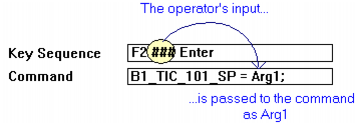
You can define a keyboard command as a key sequence, to perform a specific task each time the key sequence is pressed, for example:
A key sequence can include provision for the operator to enter data. In the following example, the operator can set the value of the variable B1_TIC_101_SP:

The operator sends out the command by pressing the F2 key, up to three characters, and the Enter key. The three character sequence (identified by the three hash (#) characters) is called an argument. The argument is passed into the command (as Arg1) when the command is completed (when the operator presses the Enter key).
The operator might type:
![]()
The value 123 is passed to the command, and B1_TIC_101_SP is set to 123.
It is recommended that you use a specific key (for example, Enter) to signal the end of a key sequence. If, for example, you use the key sequence F2 ####, the operator needs to enter 4 characters for the command to be executed - CitectSCADA waits for the fourth character. But if you use F2 #### Enter, the operator can enter between one and four characters as necessary. The command executes as soon as the Enter key is pressed.
To use more than one argument in a command, separate the arguments with commas ( , ):
To set both variables, the operator can type:
![]()
The values 123 and 18 are passed to the command. B1_TIC_101_SP is set to 123 and B1_TIC_101_PV is set to 18.